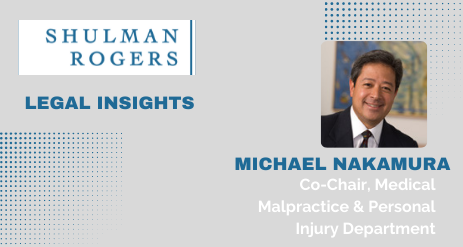
March 30, 2022
By: Michael V. Nakamura, Co-Chair
Medical Malpractice and Personal Injury Dept., Shulman Rogers
Every one of us will slip, trip or fall at some point in our lives. Sometimes these are minor incidents, and sometimes these are serious, life-altering incidents. Under the law, there are specific circumstances when such a mishap is the result of another party’s negligence, and these cases are known as premises liability cases.
Every day, I review and discuss cases with clients in the areas of personal injury, which includes auto, motorcycle, trucking, bicycle and other types of transportation-related accidents, dog bites, premises liability (slip and fall), sexual abuse and medical malpractice, which include birth injury, surgical errors, delays and misdiagnoses of many conditions and tragic wrongful death cases.
With regard to premises liability cases, a premises owner is responsible for the inspection, maintenance and repair of its premises. If there is an unsafe or dangerous condition on the property that is not immediately repairable, the owner is also responsible for appropriately warning others of this condition in the interim, usually with cones, tape or a “wet floor” sign.
However, this responsibility is accompanied by the concept of “notice,” i.e., was the premises owner on reasonable notice of the dangerous or unsafe condition? Put another way, if the owner is not aware of the unsafe condition, then it may not be reasonable to hold that owner liable for the subsequent injury on that premises. Did the unsafe condition just happen, or was it long-standing and ignored? Were there prior complaints or incidents over the unsafe condition?
If the premises owner knew or should have known through reasonable inspection of the unsafe condition, and failed to fix or warn, then liability should attach. Reasonable notice is really a case-specific analysis. For instance, there is a line of grocery store cases, often referred to as the “green bean cases,” which essentially examine how long was the green bean, or the spill in Aisle 9 there, and if longer than a reasonable period of time, then the store is liable to a customer who later fell. If a puddle of water had only been on the floor for a few minutes, and then a customer fell, that is likely not reasonably long enough to expect the owner to know about it and clean it up. Often commercial establishments have maintenance manuals and logbooks that indicate how often and how detailed a premises should be inspected, and repairs performed. If the establishment fails to comply with its own policies and procedures, then there can be a strong argument for liability.
This is a general overview, and there are other in’s and out’s to these cases, including compliance with codes, ordinances and regulations, as well as the injured party’s own behavior at the time of the incident. Was that person in a hurry, distracted, under the influence of alcohol or medication, not wearing his or her glasses? In D.C., Maryland and Virginia, a legal doctrine called contributory negligence will likely be raised by the defense, which states that even if the premises owner was negligent in some fashion, so was the injured party, and therefore, there is no case. Sometimes the argument is that the unsafe condition of the premises was so open and obvious that the injured person should have seen it. Again, this is a simplistic explanation and there are other considerations to examine in every case.
In conclusion, every premises liability case is different. The merits of your particular case really depend on very specific facts, as well as the location and jurisdiction.
For a free consultation, please contact Mike directly at mnakamura@shulmanrogers.com, or 301-230-5255.
Stay up to date with all the latest news and events.